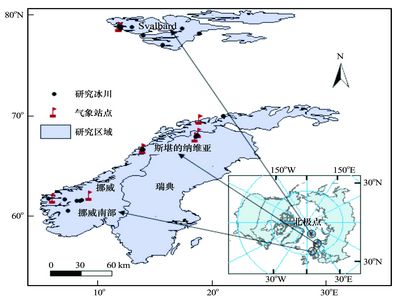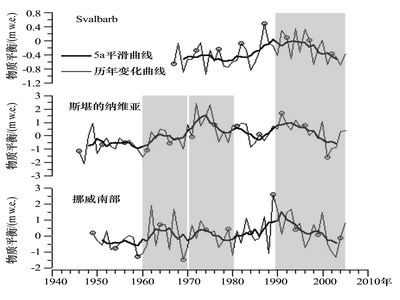Comparative Studies of the Glacier Mass-balances and Their Climatic Implications in Svalbard, Scandinavia and Southern Norway
Updatetime:2010-12-08From:
【Enlarge】【Reduce】
On the basis of the data of glacier mass balances during 1946-2005 over Svalbard, Scandinavia and Southern Norway, the characteristics of glacier mass balance are analyzed, and their sensitivities to climate change are calculated using a simple degree\|day model. The results are as followings: 1) The mass balances of glaciers in Svalbard had low annual amplitude and small interannual variability. By contrast, the mass balances of glaciers in Scandinavia and Southern Norway had large annual amplitude and interannual variability. The mass balances of glaciers in these three regions reached the maximum or comparatively high values in the late 1980s or the early 1990s. After that there was an accelerating negative tendency. 2) The mass balances of glaciers in Svalbard kept in a stable negative state between the late 1960s and the middle of 1980s, subsequently, there was a short trend to zero balance. From the late 1980s to the early 1990s, the mass balances of glaciers in Scandinavia and Southern Norway showed the characteristics of positive oscillation, but there existed difference in oscillation amplitude. 3) The sensitivity of glacier mass balance to ELA (or climatic) change was associated with mass balance condition: the glacier with more positive mass balance had higher sensitivity value, and vice versa. Maritime glacier was more sensitive to ELA (or climatic) change than continental glacier. In average, the loss of mass during 1946-2005 in these three regions was equivalent to the result of an air temperature rise of 0\^32 in relatively to zero net balance state. The highest temperature increase was found in Svalbard with 0\^55 ℃, however, only a rise of 0\^12 ℃ was found in Southern Norway. 4) The net balance sensitivity to hypothetical air temperature increase of +1 ℃ ranges from -0.42 to -0.99 m w.e.·a-1, and the net balance sensitivity to an assumed increase in precipitation of +10% varies from +0.01 to +0.57 m w.e. ·a-1, thus, 24% increase of snow precipitation is needed to compensate the net mass loss induced by air temperature increase of +1 ℃. The summer balance sensitivity to hypothetical air temperature increase of +1 ℃ varies from -0.43 to -0.87 m w.e. ·a-1, and the winter balance sensitivity to an assumed increase in precipitation of +10% ranges from +0.07 to +0.31 m w.e.·a-1. The sensitivity of glacier mass balance to climatic change is correlated with climatic and environmental backgrounds (continental/maritime): maritime glaciers have comparatively higher sensitivity than continental glaciers.
 |
 |
Appendix




